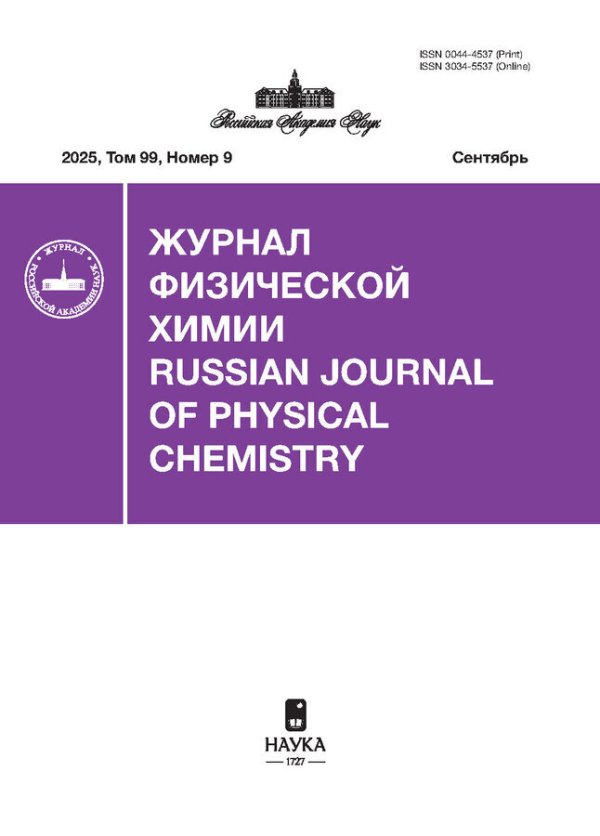Size Effect of the Electron Yield Work on Single-Crystal Silicon Samples
- Authors: Sukhorukov D.O.1, Pytskii I.S.1, Buryak A.K.1
-
Affiliations:
- Frumkin Institute of Physical Chemistry and Electrochemistry, Russian Academy of Sciences
- Issue: Vol 97, No 12 (2023)
- Pages: 1757-1762
- Section: PHYSICAL CHEMISTRY OF DISPERSED SYSTEMS AND SURFACE PHENOMENA
- Submitted: 26.12.2023
- Published: 01.12.2023
- URL: https://journals.rcsi.science/0044-4537/article/view/233067
- DOI: https://doi.org/10.31857/S0044453723120282
- EDN: https://elibrary.ru/JDRXQM
- ID: 233067
Cite item
Full Text
Abstract
Changes in electron work function (EWF) @=(ft) during the separation of Si(100) single-crystal silicon wafers into smaller samples (scribing operation) have been studied by the method of kinetic curves of EWF. The observed effect can be attributed to the sorption of water vapor on the Si(100) surface. The Helmholtz formula has been applied to estimate the amount of water absorbed by the samples, causing a change in the EWF. To determine the localization of sorbed water, we have used the method of layer-by-layer etching of the surface of Si(100) samples using low-temperature SF6-plasma. It has been shown that with a decrease in the size (area) of the samples, the size effect of the EWF takes place. For a whole plate (with an area of 80 cm2) is characterized by the EWF value close to its reference value (@=5.0) eV), while for small samples (~1 cm2), this value decreases to 4.5 eV, which indicates a significant water content in the samples (~0.3 × 1015 molecules cm–2). The data on sample etching by plasma have showed that water is unevenly distributed over the thickness of the sample, and is mainly concentrated in its deeper layers, not changed by mechanical processing (grinding and polishing). The results obtained are consistent with the theory of the secondary structure of a crystal (SSC), according to which crystalline solids have regular gaps (“T-space”) with a size of “1 atomic layer,” in which impurity transfer processes occur. Apparently, chemisorption of water takes place in the micropores of the T-space, which leads to size effects on Si(100).
About the authors
D. O. Sukhorukov
Frumkin Institute of Physical Chemistry and Electrochemistry, Russian Academy of Sciences
Email: suhorukov1010@mail.ru
119071, Moscow, Russia
I. S. Pytskii
Frumkin Institute of Physical Chemistry and Electrochemistry, Russian Academy of Sciences
Email: suhorukov1010@mail.ru
119071, Moscow, Russia
A. K. Buryak
Frumkin Institute of Physical Chemistry and Electrochemistry, Russian Academy of Sciences
Author for correspondence.
Email: suhorukov1010@mail.ru
119071, Moscow, Russia
References
- Ролдугин В.И. Физикохимия поверхности. Долгопрудный: Интеллект, 2008. 565 с.
- Дзидзигури Э.Л. // Тр. конференции “Нанотехнологии функциональных материалов. НФМ'2010”. С. 74.
- Vasilev A.A., Ivantsov M.I., Dzidziguri E.L. et al. // Fuel. 2022. V. 310. P. 122455.
- Новиков С.Н., Сухоруков О.Г., Тимошенков С.П. и др. // Журн. общ. химии. 2012. Т. 82. № 1. С. 57.
- Грег С., Синг К. Адсорбция. Удельная поверхность. Пористость. М.: Мир, 1984. 306 с. (Gregg S.J., Sing K.S.W. Adsorption, surface area and porosity. London: Academic Press, 1982. 303 p.)
- Thiel P.A., Madey T.E. // Surf. Sci. Rep. 1987. V. 7. P. 211.
- Вудраф Д., Делчар Т. Современные методы исследования поверхности. М.: Мир, 1989. 564 с. (Woodruff D.P., Delchar T.A. Modern Techniques of surface science. Cambridge: Cambridge university press, 1986. 453 p.)
- Новиков С.Н., Тимошенков С.П. // Изв. вузов. Электроника. 2002. № 5. С. 81.
- Физические величины. Справочник. М.: Энергоатомиздат, 1991. С. 568.
- Справочник по дипольным моментам. М.: Высш. школа, 1971. С. 30.
- Borman V.D., Lebedinski Yu.Yu., Trojan V.J. // Phys. Low-Dim. Struct. 1998. V. 7–8. P. 167.
- Веснин Ю.И. Вторичная структура и свойства кристаллов. Новосибирск: Издательство СО РАН, 1997. С. 16.
Supplementary files
















